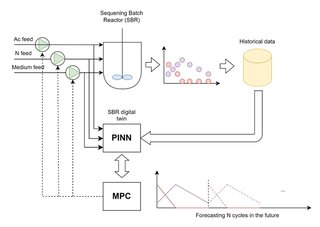Speaker
Description
Keywords: Biopharma 4.0, Deep learning, Physics Informed Neural Networks, Bioreactors, Digital Twin
Abstract
Hybrid modeling combining First-Principles with Machine Learning (ML) is becoming a pivotal methodology for Industry 4.0 enactment. The combination of ML with prior knowledge generally improves the model predictive power and transparency while reducing the amount of data for process development. There is, however, a research gap between emerging machine learning methods and the current practice in bioprocess development [ 1 ].
In this work, we present an automatic control system that makes use of Physics Informed Neural Networks (PINNs) [ 2 ] to act as a digital twin of a natural microbiome in a Sequencing Batch Reactor (SBR) in order to maximize Polyhydroxyalkanoates (PHA) production through the control of 3 different feeds: An Acetate/culture medium solution, an Ammonia/culture medium solution and a culture medium solution (Figure 1).
Firstly, the PINN model was trained with historical data from a Sequencing Batch Reactor (SBR). During this step, deep learning centric approaches, such as the Adaptive Moment Estimation Algorithm (ADAM) were used. After the PINN was trained, a Model Predictive Control (PC) control step was carried out. The PINN model acted as a digital twin of the process to forecast the dynamics of the SBR based on process measurements and 3 decision variables: Feeding rate of acetate, feeding rate of ammonia and feeding rate of medium. Afterwards, based on the forecast, the MPC selects the parameters that maximize the productivity of the next feast and famine cycle (defined as the amount of biomass (VSS) multiplied by the amount of PHA at the end of the feast).
After a total of 14 cycles, corresponding to 3 hydraulic retention times, the PHA has increased from the starting 5 mg/gVSS in 14 g/L of VSS to 226 mg/gVSS in 6.5 g/L of VSS. This was further confirmed via a dedicated accumulation experiment, which resulted in 528 mg/gVSS in 10 g/L of VSS.

Figure 1. Hybrid control system schematic
References
[ 1 ] Agharafeie, R., Oliveira, R., Ramos, J. R. C., & Mendes, J. M. (2023). Application of hybrid neural models to bioprocesses: A systematic literature review. Authorea Preprints.
[ 2 ] Raissi, M., Perdikaris, P., Karniadakis, G. E., 2019. Physics-informed neural networks: Adeep learning framework for solving forward and inverse problems involving nonlinear partial differential equations. J. Comput. Phys. 378, 686–707. https://doi.org/10.1016/j.jcp.2018.10.045
| Type of presentation | Contributed Talk |
|---|
